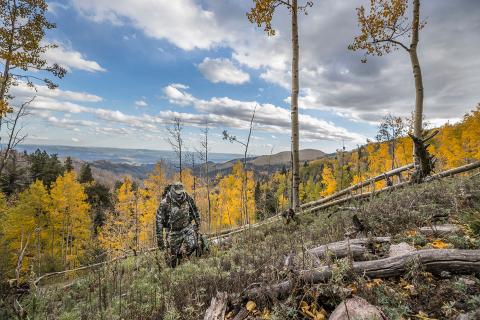Jeff Dennis | Originally published in GameKeepers: Farming for Wildlife Magazine. To subscribe, click here.
The use of prescribed fire is the most cost effective landscape scale management tool available, but variables can dictate how and when to apply it. Too wet and fuels won’t burn, too dry and you risk tree damage, injured or dead wildlife, or angry neighbors. Reading the current conditions is important for managers selecting a burn plan from their playbook. Keeping parts of the forest in the earliest stages of succession can become an addicting art form for some, and these “fire-keepers” can’t wait for the annual chance to burn their woods and watch as the habitat evolves.
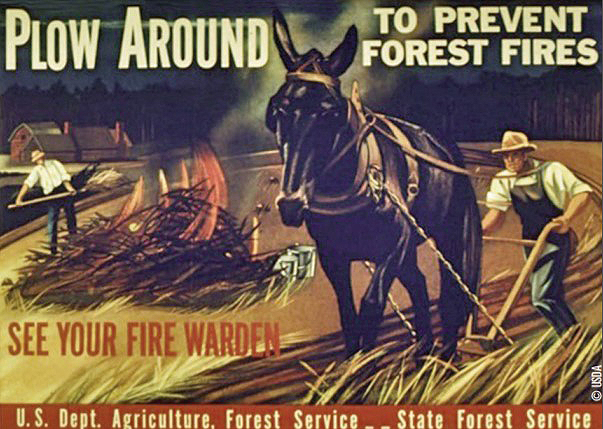
Geologists say that studying sand on the beaches of barrier islands is like watching the earth change at fast speed. Normally, for humans, our point of view is very slow to develop when observing nature, such as when studying the growth of a tree. Prescribed fire can also allow humans this fast forward type of view, especially when completing a regular regime of fire on the same areas over time. Old grasses and other fuels are burned leaving a blackened landscape that is quickly reborn with green growth in spring.
Plowing Firebreaks
Plowing firebreaks around an entire property makes good sense, but one should also consider plowing some inner firebreaks in order to break up the property into smaller “burn units.” These smaller units allow more options on days when the wind is not right for one tract, but the temperature and humidity is still optimal for burning on another adjacent piece. Multiple firebreaks allow fire-keepers to rotate which tracts are burned each year, creating a mosaic of habitats which biologists have cited as a solid practice to benefit wildlife.
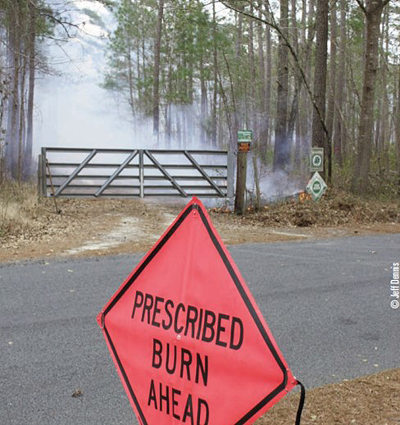
of prescribed fire among would be fire-keepers.
Fire-keepers would be wise to have signage available to
place on nearby roads indicating to watch for smoke both
during and after the burn.
Firebreaks are essential to establish before prescribed fire plans can be executed and there are a couple of ways to create them, and in most cases heavy equipment is required. A large tractor can drag a fire plow implement that splits the top layer of the earth, throwing dirt to each side to create a ditch-style firebreak. Using the blade on the front of a bulldozer can create a wider and flatter firebreak that is also sufficient to stop an approaching prescribed burn. In each case, breaking the root mat of the forest floor is often a tough job.
The first pass on a new firebreak will always be the hardest, and that first-year firebreak may appear rough for those who value aesthetics. However, each successive year the firebreak is plowed or disked, it becomes easier to manipulate and takes on a more polished look. At first it really doesn’t have to be attractive, just effective. At their highest point of value, returns such as property access and even “ribbons” of food plots can be derived from firebreaks.
Fire-keepers are never hesitant to fine-tune their firebreaks over time. Often the first firebreak is a straight-line implementation, and adding a box cut out around a particular area like a hardwood grove might make sense later. Predominant winds are revealed when active fires are burning, and it may become clear after the first burn where a backup firebreak might be wise. If you are a fire-keeper, and a redundant fire line hasn’t saved your bacon once before, then you’re not setting out enough prescribed fire.
Backfire Basics
Setting a controlled fire to run into a steady breeze is one of the surest methods to burn woodlands in a safe manner. The baseline for this type of burn is the firebreak that is downwind. Fire-keepers will stand in the firebreak and use a drip torch filled with 25-percent gas and 75-percent diesel to set a fire that moves away from the baseline. A backing fire burns slow and is thus cooler than any other fire such as flanking fire or a head fire.
A cool fire burns evenly through the woods without flaring up the kind of temperatures that can damage trees. Killing trees is not the objective of prescribed fire, but it can happen. The long-term goal of regular fire is to improve the timber stand. Like other aspects of farming for wildlife, a trial and error period exists with prescribed fire. A few trees will be lost in the process, but overall this helps the fire-keeper to better envision what a healthy ecosystem maintained by fire looks like.
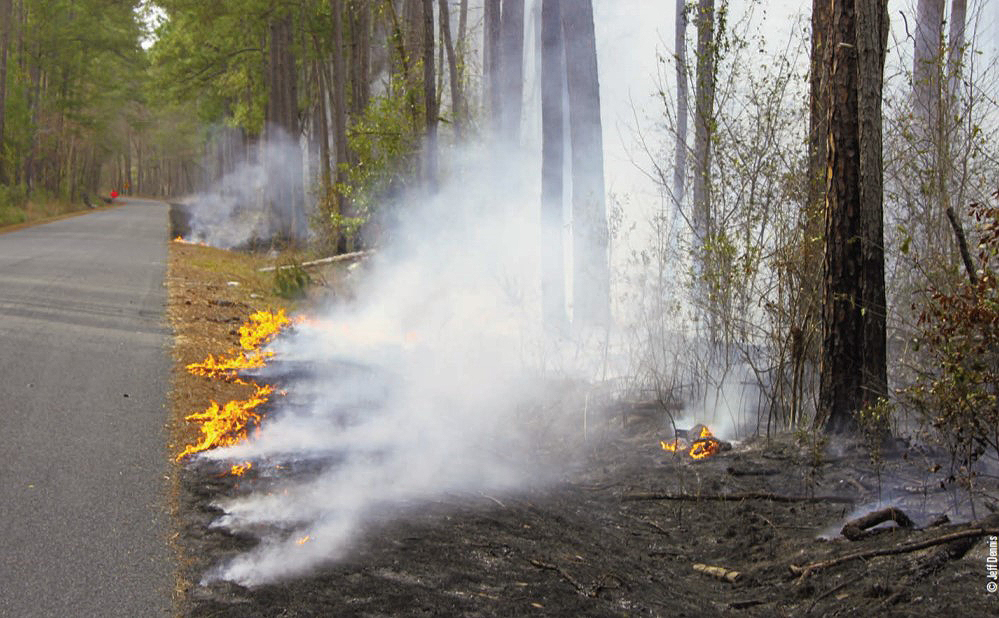
Always set out some test fire in a corner of the burn block to see how the forest litter actually ignites. The conditions may seem right, but the fuel will let you know if it’s ready to roll. Once you set the backfire you are not on easy street until a slow-burning fire traverses every inch inside the firebreaks. That’s because any fire reacts to sudden changes in wind speed and wind direction, and they almost certainly will come.
All firebreaks around any backfire need to offer plenty of exposed dirt to disable an advancing fire, and that is not always enough. In the areas of the South with loamy soils the woody vegetation can grow high enough so that it sags over a firebreak, and if the conditions are right the fire will jump the break in an airborne manner that makes fire-keepers shake their heads. Once a prescribed fire is out of the burn block, fire keepers understand why it is best to have all the property firebreaks maintained.
Smoke Management
Limiting liability is the name of the game in controlled burning when it comes to the smoke produced from a prescribed fire. Strong winds aloft are needed to disperse the smoke into the atmosphere without causing any smoked-in conditions where people live or across roadways. Smoke liability is the single greatest threat to the expansion of prescribed fire among would be fire-keepers. Many areas of the country evolved with fire, and today's landscape needs all it can get to retain its diversity.
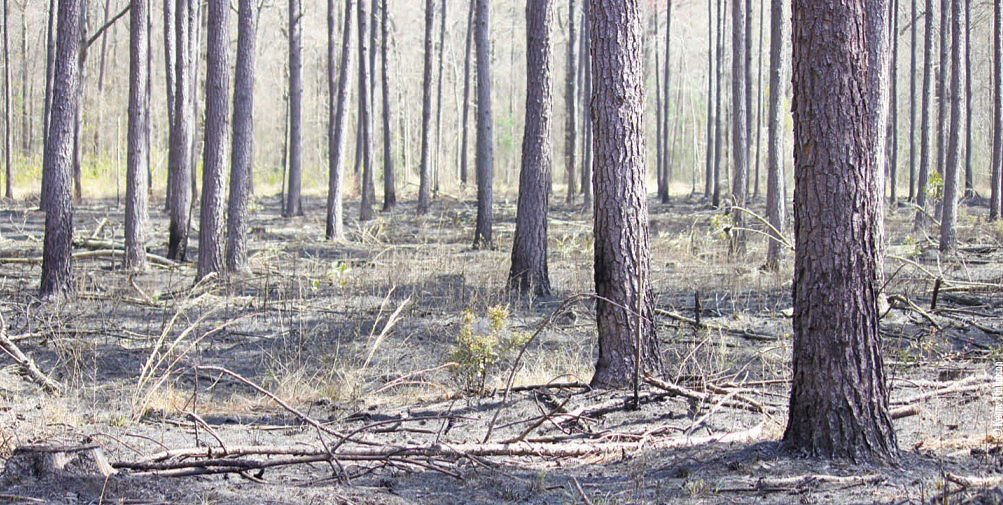
Inversion is when the smoke will not disperse and instead tries to hug the earth. In many cases inversion does not set in until the end of the day, after a burn, when thermals start to cool and pull downward. However, stumps continue to smolder and snag trees can remain aflame well after a controlled burn, and they can produce enough smoke to cause concern. Fire-keepers would be wise to have signage to place on any nearby roads indicating to watch for smoke both during and after the burn. Except in the driest of conditions, these holdover fires usually go out by morning, and are easy to identify by their glow after darkness arrives.
Hotspot Hotshot
A controlled burn begins with firebreak vigilance and it doesn’t end when the flames that were walking through the burn block have reached their intended "roadblock.” Strange things can happen from time to time, so a fire-keeper can break for a meal or perhaps a shower to part with any soot that was earned during the day, but they better check back in the woods before leaving the property for the day. Oftentimes a backpack sprayer is the right tool for mopping up hotspots, even if it is only to provide piece of mind for the fire-keeper who wants to sleep without worry.
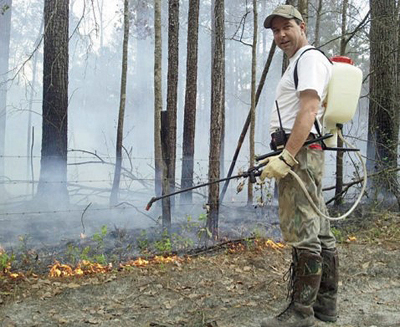
Oftentimes a backpack sprayer is the right tool for mopping
up hotspots.
One trick of the trade is to add an ounce of surfactant to the water in the backpack sprayer, which makes the fluid better stick to the burning wood, especially effective when pine tree sap is aflame. Snag trees still burning in the middle of a burn block don’t warrant much attention, but one burning near a firebreak with plenty of fuel on the other side can be a deal breaker when it comes to calling it a day. If you have ever walked the firebreaks on a proverbial mission to identify hotspots long after a prescribed burn then you might already call yourself a “fire-keeper.”
Pine vs. Hardwood
Can you burn through a hardwood stand? The answer is yes. Burning through hardwood bottomlands is not as popular as burning through piney woods, since hardwoods are more susceptible to damage from the heat of a prescribed fire. But the decision to burn in hardwoods correlates with the fact that natural fires have always run from uplands to bottomlands. If you choose not to burn in hardwoods, simply plow a firebreak in order to exclude fire from that area.
For pines, it matters what variety you are burning, with longleaf pine they are all but immune to prescribed fire after one year of age. Shortleaf, loblolly and slash pines can all be killed by fire if burned too young, but they become much more hearty with age. Fire-keepers can master the appearance of a pine stand after successive burns, creating a parklike appearance and an open understory. Besides benefitting wildlife, a major advantage is the reduction of fuel loads and much less chance of wildfire all year long.















